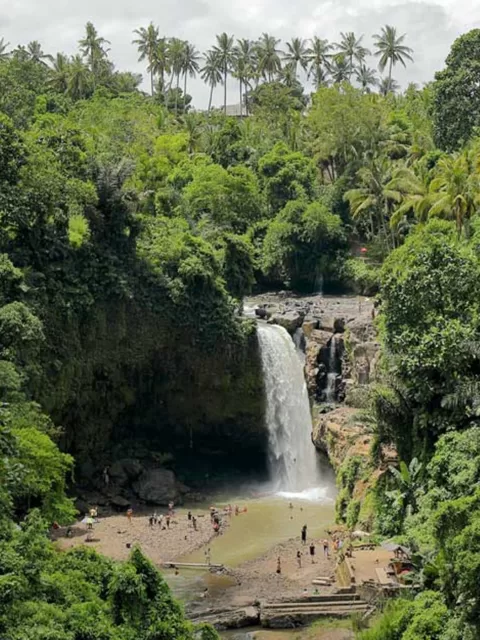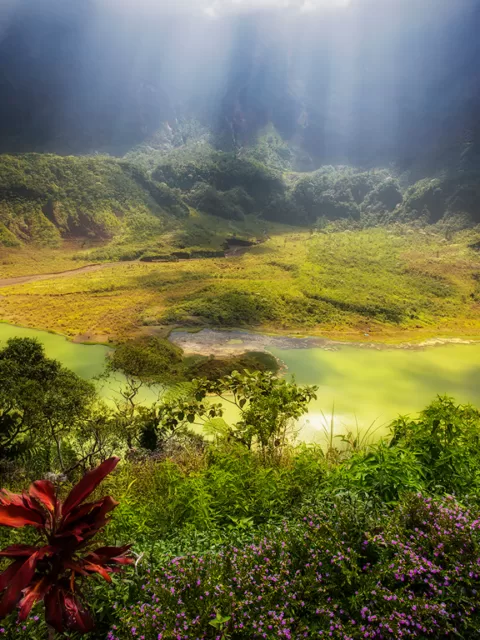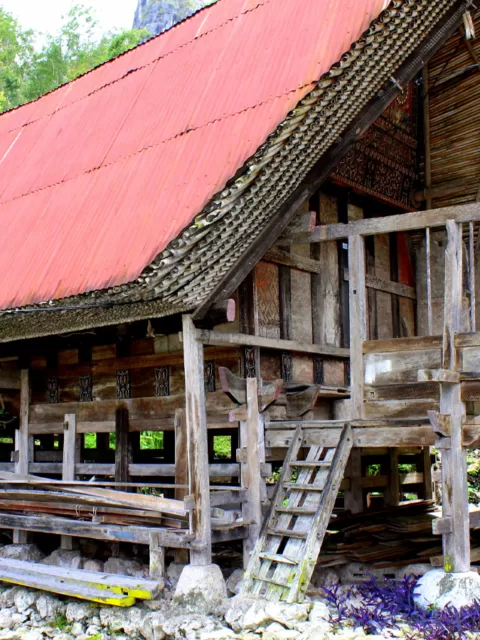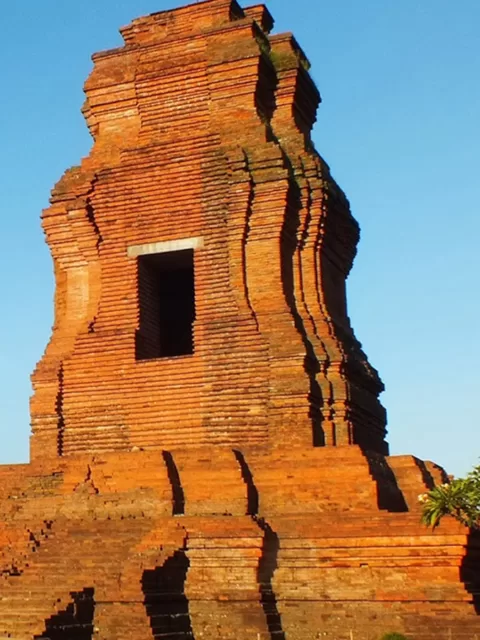Experience Uluwatu Temple: Where Culture and Cliffs Meet
Discovering Uluwate Temple
The Magnificence of the Uluwatu Temple’s Location
Perched atop a towering limestone cliff along Bali’s southwestern coast, Uluwatu Temple is a sight to behold. The temple complex offers breathtaking views of the Indian Ocean, with its crashing waves and endless horizon. At sunset, the sky is ablaze with color, creating a truly magical scene.
Uluwatu Temple’s Place in Balinese Spirituality
Uluwatu Temple is one of the nine directional temples in Bali, and it is considered to be one of the most sacred sites on the island. The temple is dedicated to the sea god, Sang Hyang Baruna, and it is believed that the cliff serves as a spiritual barrier between the human world and the realm of the gods.
First Impressions: The Gateway to Uluwatu Temple
Upon entering the Uluwatu Temple complex, visitors are greeted by a towering stone gate adorned with intricate carvings. The gate is flanked by two statues of the guardian spirits, Niskala and Sekala. These spirits are said to protect the temple from evil spirits and negative energies.
Historical Significance of the Uluwatu Temple
The Origins and Legends Associated with the Temple
The origins of Uluwatu Temple are shrouded in mystery, but legend has it that the temple was founded in the 11th century by the Hindu priest Dang Hyang Nirartha. Nirartha is said to have meditated on the clifftop for several years, and he eventually attained enlightenment. To commemorate this event, he built a small shrine on the clifftop, which eventually evolved into the Uluwatu Temple complex.
Role of Uluwatu Temple in Balinese Kingdoms
Uluwatu Temple has played an important role in Balinese history for centuries. The temple was a major religious and cultural center for the Gelgel Kingdom, which ruled Bali from the 14th to the 17th centuries. The temple was also a strategic military outpost, as it provided a vantage point over the Indian Ocean.
Major Events and Ceremonies Held at Uluwatu Temple
The Temple is the site of several important Balinese ceremonies throughout the year. One of the most significant ceremonies is the Kecak dance performance, which is held every evening at sunset. The Kecak dance is a traditional Balinese dance that tells the story of the Ramayana, an epic Hindu tale.

Another important ceremony held at Uluwatu Temple is the Galungan ceremony. Galungan is a Balinese New Year ceremony that celebrates the victory of good over evil. During the Galungan ceremony, the temple complex is decorated with colorful banners and flowers, and special offerings are made to the gods.
Architectural Wonders of the Uluwatu Temple
Unique Features of Uluwatu Temple’s Design
The Temple is a remarkable example of Balinese architecture. The temple complex comprises several different structures, including shrines, gates, and pavilions. The structures are built from black volcanic stone and are adorned with intricate carvings.
One of the most unique features of Uluwatu Temple is its clifftop location. The temple is perched on the edge of a 70-meter cliff, offering breathtaking views of the Indian Ocean. The clifftop location also makes Uluwatu Temple a popular spot for sunset viewing.
Influence of Hindu Architecture on the Temple
Hinduism heavily influenced the architecture of the Temple. The temple complex is divided into two main areas: the outer courtyard and the inner courtyard. The outer courtyard is open to the public and is home to several shrines and pavilions. The inner courtyard is more sacred and is reserved for religious ceremonies.

Stone Carvings and Symbols: Interpreting the Temple’s Facades
The stone carvings and symbols on the facades of Uluwatu Temple tell stories from Hindu mythology and cosmology. Some of the most common carvings include:
- Garuda: The mythical bird that is the vehicle of the god Vishnu.
- Naga: The mythical serpent that is associated with water and fertility.
- Kala: The demon of time and death.
- Bhoma: The dwarfish son of the god Shiva.
By interpreting the stone carvings and symbols on Uluwatu Temple’s facades, visitors can gain a deeper understanding of the temple’s religious and cultural significance.
The Kecak Dance at the Temple
Origins and Significance of the Kecak Performance
The Kecak dance is a traditional Balinese dance that tells the story of the Ramayana, an epic Hindu tale. The dance is performed by a group of male dancers who chant, clap, and stomp in a rhythmic pattern. The dancers are accompanied by a gamelan orchestra, which provides the musical accompaniment.
The Kecak dance is believed to have originated in the early 20th century. The dance was created by a Balinese dancer named Wayan Limbak, who was inspired by the trance-like state that traditional Balinese healers would enter into when performing healing rituals.

Experiencing the Kecak Dance against Uluwatu Temple’s Sunset
The Kecak dance is a truly mesmerizing experience. The dancers’ chanting, clapping, and stomping create a primal energy that is both captivating and awe-inspiring. The performance is even more spectacular when it is set against the backdrop of Uluwatu Temple’s sunset.
How Uluwatu Temple Provides the Perfect Backdrop for the Dance
Uluwatu Temple provides the perfect backdrop for the Kecak dance for several reasons. First, the temple’s clifftop location offers stunning views of the Indian Ocean, which creates a truly magical setting for the performance. Second, the temple’s sacred atmosphere helps to create a sense of reverence and awe. Finally, the temple’s acoustics are perfect for the Kecak dance, as the sound of the dancers’ chanting and clapping reverberates throughout the complex.
Stunning Views from the Temple’s Cliff Edge
Overlooking the Vastness of the Indian Ocean
One of the best things about visiting Uluwatu Temple is the stunning views from the cliff edge. Visitors can overlook the vastness of the Indian Ocean, with its crashing waves and endless horizon. The views are especially spectacular at sunset when the sky is ablaze with color.

Best Spots at Uluwatu Temple for Panoramic Vistas
The best spots at Uluwatu Temple for panoramic vistas are the clifftop viewing platforms. These platforms offer unobstructed views of the Indian Ocean and the surrounding coastline. Visitors can also get great views from the temple complex itself, such as the Bale Pesinggahan pavilion and the Pura Luhur Uluwatu temple.
The Connection Between Uluwatu Temple’s Location and Spirituality
The connection between Uluwatu Temple’s location and spirituality is significant. The temple’s clifftop location raises it above the mundane world, bringing it closer to the realm of the gods. The temple is also said to be located at a spiritual energy vortex, making it a powerful place for meditation and prayer.
Cultural and Spiritual Etiquette at the Temple
Proper Attire for Visitors to Uluwatu Temple
When visiting Uluwatu Temple, it is important to dress appropriately. Visitors should wear long pants or skirts and cover their shoulders. Visitors can also rent sarongs and sashes at the temple entrance.
Participating in Prayer and Offering Rituals at Uluwatu Temple
Visitors to Uluwatu Temple are welcome to participate in prayer and offering rituals. Priests are available to assist visitors with these rituals. Visitors can also purchase offerings from the vendors located outside the temple entrance.
Respecting the Sanctity of the Temple’s Grounds
Uluwatu Temple is a sacred place, and it is important to respect the sanctity of the grounds. Visitors should be quiet and respectful, and they should avoid touching any of the temples or statues. Visitors should also be aware of their surroundings and avoid stepping on any offerings.
Wildlife at the Temple: The Mischievous Monkeys
Uluwatu Temple is home to a large population of long-tailed macaques. These monkeys are known for their cheeky and naughty behavior. They are often seen stealing food from visitors and swinging through the trees.

The Significance of Monkeys in Balinese Culture
Monkeys are considered to be sacred animals in Balinese culture. They are associated with the god Hanuman, who is known for his strength, courage, and loyalty. Monkeys are also believed to be able to protect people from evil spirits.
Tips for Interacting with Monkeys at Uluwatu Temple
While the monkeys at Uluwatu Temple are generally harmless, it is important to be respectful of them and to avoid interacting with them too closely. Here are a few tips:
- Do not feed the monkeys. Feeding the monkeys can encourage them to become aggressive and beg for food.
- Do not touch the monkeys. Touching the monkeys can stress them out and make them more likely to bite.
- Be aware of your belongings. The monkeys are known for stealing food and other items from visitors.
- If a monkey approaches you, try to stay calm and do not make any sudden movements.
The Dual Role of Monkeys: Protectors and Tricksters of the Temple
The monkeys at the Temple play a dual role as both protectors and tricksters. On the one hand, they are believed to protect the temple from evil spirits. On the other hand, they are known for their mischievous behavior and their tendency to steal from visitors.
Despite their mischievous nature, the monkeys are an integral part of the Uluwatu Temple experience. They add a touch of whimsy and excitement to the visit, and they remind visitors of the deep connection between nature and spirituality in Bali.
Planning Your Visit to the Uluwatu Temple
Best Times to Visit Uluwatu Temple for a Spiritual Experience
The best time to visit Uluwatu Temple for a spiritual experience is during the early morning or evening hours. During these times, the temple is less crowded and the atmosphere is more peaceful.
Transportation and Access
Uluwatu Temple is located about 20 kilometers south of Kuta. Visitors can get to the temple by taxi, motorbike, or rental car. There is also a public bus that runs to the temple from Kuta.
Nearby Attractions to Combine with Your Temple Journey
There are a number of other attractions located near Uluwatu Temple that visitors can combine with their visit. These attractions include:
- Tanah Lot Temple: A Hindu temple that is perched on a rock formation in the ocean.
- Nusa Dua Beach: A beautiful beach with white sand and clear water.
- Waterblow: A natural rock formation that shoots seawater high into the air.

- Garuda Wisnu Kencana: A massive statue of the Hindu god Vishnu riding the mythical bird Garuda.
- Jenggala Keramas Beach: A black sand beach with stunning views of Mount Agung.
Reflecting on the Uluwatu Temple Experience
The Temple is a truly unique and special place. It is a place where culture, nature, and spirituality converge. Visitors to the temple can experience the beauty of Balinese architecture, the power of Balinese spirituality, and the wonder of the natural world.
Uluwatu Temple as a Symbol of Balinese Heritage and Spirituality
The Temple is more than just a tourist attraction. It is a symbol of Balinese heritage and spirituality. The temple has stood for centuries, and it has witnessed the rise and fall of kingdoms, the changing of cultures, and the forces of nature. Uluwatu Temple is a testament to the resilience of the Balinese people and their deep connection to their faith.
The Lasting Impressions of the Temple’s Landscape and Culture
Uluwatu Temple is a place that leaves a lasting impression on visitors. The temple’s stunning clifftop location, its sacred atmosphere, and its rich culture are all unforgettable. Visitors to Uluwatu Temple often leave with a sense of awe and wonder, and they feel inspired by the temple’s beauty and spirituality.
An Invitation to Revisit and Delve Deeper into the Temple’s Mystique
Uluwatu Temple is a place that can be visited over and over again. Each visit will reveal something new about the temple’s history, culture, and spirituality. Visitors who are interested in learning more about Balinese culture are encouraged to revisit Uluwatu Temple and delve deeper into its mystique.
I hope this article has given you a better understanding of Uluwatu Temple and its importance to the Balinese people. I encourage you to visit this amazing place for yourself and to experience its magic firsthand.












